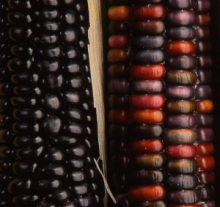Article
Corn is a cereal plant, found throughout the Americas, that yields large grains, or kernels, set in rows on a cob. What we call corn today, however, has traditionally been referred to as maize. For many indigenous cultures in the Americas, corn is symbolic of life itself, and everything from its pollen, to its silky tassels, to its husks has symbolic significance. Thus, it becomes possible for a small boy to take scraps of corn husk and create an imaginary insect that turns into a messenger to the gods, which occurs in a Zuni myth retold by Hillerman as "The Boy Who Made Dragonfly." Even the smallest piece of this special plant is powerful enough to not only sustain but also to generate life.
Several of the other ceremonials described in Hillerman's fiction also use corn, its husks and pollen, in order to complete the rituals as per the Navajo Way as the Holy People prescribed.
"Indian corn, 1993," photograph by Eduardo Fuss, Eduardo Fuss Photograph Collection (2011-001-b1-f1-0004), Center for Southwest Research, University of New Mexico.
Manuscripts
A01 The Blessing Way (01-07) p. 45
A01 The Blessing Way (01-07) p. 47
A01 The Blessing Way (01-07) p. 58
A01 The Blessing Way (01-07) p. 84
A03 The Boy Who Made Dragonfly (06-08) p. 11
A03 The Boy Who Made Dragonfly (06-08) p. 12
A03 The Boy Who Made Dragonfly (06-08) p. 13
A03 The Boy Who Made Dragonfly (06-08) p. 14
A03 The Boy Who Made Dragonfly (06-08) p. 15
A03 The Boy Who Made Dragonfly (06-08) p. 16
A03 The Boy Who Made Dragonfly (06-08) p. 17
A03 The Boy Who Made Dragonfly (06-08) p. 18
A03 The Boy Who Made Dragonfly (06-08) p. 19
A03 The Boy Who Made Dragonfly (06-08) p. 22
A03 The Boy Who Made Dragonfly (06-08) p. 23
A03 The Boy Who Made Dragonfly (06-08) p. 24
A03 The Boy Who Made Dragonfly (06-08) p. 26
A03 The Boy Who Made Dragonfly (06-08) p. 29
A03 The Boy Who Made Dragonfly (06-08) p. 31
A03 The Boy Who Made Dragonfly (06-08) p. 32
A03 The Boy Who Made Dragonfly (06-08) p. 36
A03 The Boy Who Made Dragonfly (06-08) p. 37
A03 The Boy Who Made Dragonfly (06-08) p. 39
A03 The Boy Who Made Dragonfly (06-08) p. 43
A03 The Boy Who Made Dragonfly (06-08) p. 44
A03 The Boy Who Made Dragonfly (06-08) p. 45
A03 The Boy Who Made Dragonfly (06-08) p. 46
A03 The Boy Who Made Dragonfly (06-08) p. 47
A03 The Boy Who Made Dragonfly (06-08) p. 48
A03 The Boy Who Made Dragonfly (06-08) p. 49
A03 The Boy Who Made Dragonfly (06-08) p. 51
A03 The Boy Who Made Dragonfly (06-08) p. 53
A03 The Boy Who Made Dragonfly (06-08) p. 55
A03 The Boy Who Made Dragonfly (06-08) p. 59
A03 The Boy Who Made Dragonfly (06-08) p. 60
A03 The Boy Who Made Dragonfly (06-08) p. 61
A03 The Boy Who Made Dragonfly (06-08) p. 62
A03 The Boy Who Made Dragonfly (06-08) p. 63
A05 Listening Woman (02-13) p. 16
A05 Listening Woman (02-13) p. 121
A05 Listening Woman (02-13) p. 122
References
Malotki, Ekkehart, and Lomatuway’ma, Michael
1987 Maasaw: Profile of a Hopi God. American Tribal Religions. Lincoln: University of
Nebraska Press.
Reichard, Gladys Amanda
1950 Navaho Religion: A Study of Symbolism. New York: Bollinger Foundation.
Stevenson, Matilda Coxe Evans
1904 Zuni Indians: Their Mythology, Esoteric Fraternities, and Ceremonies. U.S. Bureau of
American Ethnology. Twenty-Third Annual Report. 1901-1902. Washington: Government
Printing Office.
Whiting, Alfred F.
1939 Ethnobotany of the Hopi. Bulletin. Flagstaff: Northern Arizona Society of Science and
Art.

